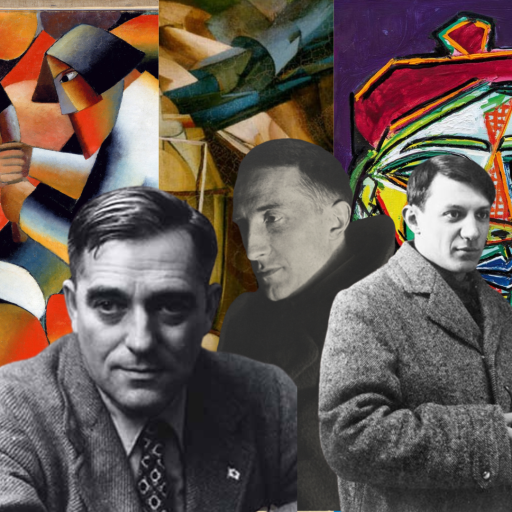Modernist Art
15 Ekim 2022Kenana Albazal
The rise of modern art can be traced back to the 1860s, a period within which a wide variety of styles and movements emerged to communicate the unorthodox, question conservative ideals, and declare the autonomy of art. The unfolding fast-paced society influenced artists during the industrial revolution that demanded a similar-paced transformation to the essence of art. In this paper, I will be discussing the pioneering traits of modernist art in terms of its formalistic and contextual qualities, examining the theories and achievements of the artists Pablo Picasso, Marcel Duchamp, and Kazimir Malevich, and bringing into focus how they depicted the modern experience and defied the ways of the old masters.
The nineteenth century was a period of tremendous and rapid change; due to the Industrial Revolution, massive developments in technology, manufacturing, and transportation began to impact the way of living. The intrusion of commercial values into every level of cultural behaviors and practices in Western societies and a resulting feeling of psychic alienation promoted artists to want to break free from any type of commodification in art and social institutions where such attitudes were engraved (Cottington, 2005). Artists experimented with new subject matters portraying concepts, people, or modern cities they found appealing. If we examine different eras of modern art, we can observe how reflective art movements or single artworks are of their time. For example, realist paintings rendered the switch in people’s political thought and social consciousness. Additionally, Surrealism was shaped by the theory of “sub consciousness” that became widespread after Sigmund Freud published “The Interpretation of Dreams.” Thus, art production was very diverse and could not be narrowed down to a few qualities or characteristics. Artists explored new types of art, such as collage art, kinetic art, and photography; they also experimented with the use of color, as seen in Fauvism or Expressionist pieces. New techniques and materials were also employed; for instance, Picasso used newspaper, tin cans, and junk to produce his paintings and sculptures.
Moreover, Picasso was a co-founder of Cubism, which was the first modernist rupture from previous artistic conventions. With the beginning of modern art in 1914, the theory of formalism was being established and assigned to modern art, focusing on an artwork’s significant form, its lines, color, and composition on a plane surface; this was precisely what Picasso was trying to achieve. Picasso and Braque both used the concept of a linear “grid” on canvas, which defied standard perspective and pictorial coherence and developed into a signature of modern art. Also, during a period named “synthetic Cubism,” Picasso experimented with a variety of mixed media; he utilized slogans, newspapers, and placards to characterize the real world, which at the time witnessed an escalation of commercial advertising (Witham, 2013).
Other modern artists such as Marcel Duchamp desired to intellectualize art, to shed light on “ideas” rather than mere visual effects. In his affirmation about the ready-mades, Duchamp claimed that his choices never regarded aesthetic pleasure; his intention was instead a visual obliviousness and a lack of good and bad taste; he even specified it as a “complete anesthesia,” stating that it was the concept of amusement that pushed him to experiment further. Some regarded the ready-mades as the “idea art”; others predicted that the central concept was their lack of originality and value, preserving them from being seized by consumerism. Roger Shattuck, a literary historian, argued that the goal is a singular, anti-art jolt (Witham, 2013).
Another significant modern artist is Kazimir Malevich, a pioneer of the Russian avant-garde and a founder of the school of Suprematism. Malevich aspired to introduce a new order to the world around him; he aimed not to modify art but to modify the world via shapes and colors. In 1915, “Zero, ten” was the last Futurist exhibition, after which the Russian avant-garde underwent an unstoppable growth. The exhibition displayed Malevich’s “Black Square” and 38 non-figurative Suprematist pieces that challenge the essence of art. At the same time, “Zero,” in the name of the exhibition, stands for the “nullity of forms,” symbolized by the Black Square (Yelshevskaya, n.d. – a). Suprematism was defined by its geometric abstraction, as geometry was a symbol of wholeness, according to Malevich. Hence, the universe was minimized to nothing but a group of geometrical shapes.
Furthermore, other than Suprematism, Malevich was influential in many ways in the Russian Avant-Garde era. A poetic theory called “Zaum,” which translates to “beyond the rationale,” was constructed by Russian Futurist writers, Khlebnikov and Kruchenykh; it involved breaking conventional rules of language, narrative structure, and syntax. The growth of Zaum in Russian literature, and the prevalence of French Cubism among Russian avant-gardes, occurred during the same period. Meanwhile, the philosopher Matyushin was finding the relationship between the fourth dimension in Cubism and a greater state of consciousness, or what he called “higher intuition,” Which Malevich became familiar with During 1913 alongside the theory of Zaum (Lodder, 1996). On that account, Malevich joined the Futurist authors in a number of projects, including the opera “Victory over the Sun,” after which they announced their goal to demolish the outdated movement of thought in compliance with “the theory of causality, symmetrical logic and toothless common sense.” (Douglas, 1975).
Lastly, “Cow and Violin” is one of Malevich’s paintings that seemed to mostly incorporate his ideas influenced by the Zaum theory. It is stated that the painting depicts an instant of struggle, a clash between two forms, a cow and a violin. The pictorial space in the paintings is not just unclear; it’s also completely irrational. Malevich exploited the spatial and pictorial freedom of Cubism in a Zaum fashion, merging inharmonious components to undermine assumptions of reality (Lodder, 1996). The cow and violin belong to contrasting domains in society. One characterizes rural life in Russia; the other is firmly rooted in Western urban culture. These different symbols may represent the socioeconomic divide in Russia between the lower class, the intelligentsia, and the aristocratic class, as well as the international divide between Russia and Western civilization.
In conclusion, the desire for individualism and originality were key characteristics of Modern Art. Artists including Picasso, Duchamp, and Malevich lived and made art in the same period; all were somehow influenced by each other, yet each one of them is famous for their own distinct inventions. They refused the bourgeoisie lifestyle and questioned notions regarding how art should and should not be and the standards under which art is judged. They also challenged the demand for aesthetic pleasure and a moral or meaningful context. Hence, a modern piece could be irreverent; it could be ugly or utterly meaningless without descending in value.
References
- Cottington, D. (2005). Modern art: A very short introduction. Oxford University Press.
- Douglas, C. (1975). Suprematism: The Sensible Dimension. The Russian Review, 34(3), 266–281. https://doi.org/10.2307/127974
- Lodder, C. (1996, April). The transrational in painting: kazimir malevich, alogism and zaum‘. Forum for Modern Language Studies. 32(2), 119–136. https://doi.org/10.1093/fmls/XXXII.2.119
- Witham, L. (2013). Picasso and the chess player: Pablo Picasso, Marcel Duchamp, and the battle for the soul of modern art. University Press of New England.
- Yelshevskaya, G. (n.d.-a). How Malevich, Kandinsky, Rodchenko, Tatlin, Larionov, and others created the radically new art of the 20th century. Arzamas. https://arzamas.academy/materials/1231
- Yelshevskaya, G. (n.d.-b). Artistic Life in the Soviet Union after the October Revolution of 1917. Arzamas. https://arzamas.academy/materials/1232

